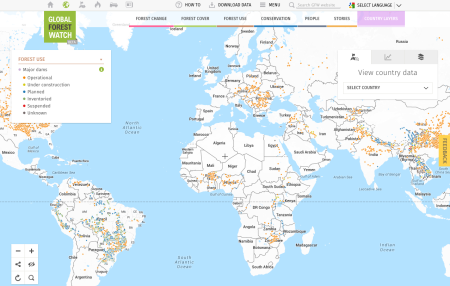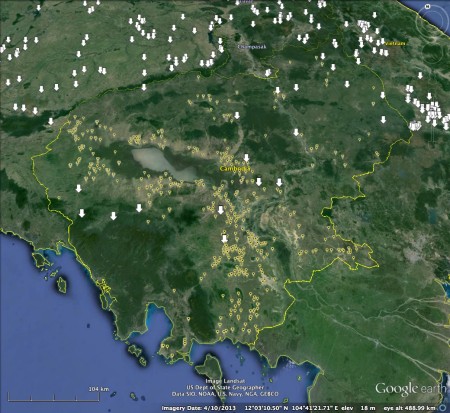Readers with a longish memory may remember a somewhat hyperbolic piece about the existential threats to chocolate that we linked to late last year. There was a lot of that sort of talk going around at the time, for some reason. Perhaps a ploy by greedy multinationals to justify price increases? Anyway, there’s a fun video out now, showcasing CATIE’s role in the whole saving chocolate thing.
Dam the genetic resources, full speed ahead
Global Forest Watch now has a dam dataset, covering 50 major river basins. Here’s what it looks like:

You can mash it up online with various forest datasets, but you can also download it as a kml. Which of course means you can mash it up with your own dataset. That’s what I’ve done here with wild rice from Cambodia. The white arrows are dams, most of them either planned or under construction, the yellow dots samples of wild Oryza according to Genesys.

You’ll notice a few dams with few or no nearby specimens. Off the top of my head, those would seem to be places where collecting might be in order, before the disruption goes too far. But what do the rice experts out there think?
LATER: Seems I might be on to something…
@AgroBioDiverse @RiceResearch @BrianFLloyd And not just rice of course. Yes, I would expect a serious consequence.
— Mike Jackson OBE (@mikejackson1948) May 5, 2015
Featured: TR4
Anne Vezina thinks the media is misleading us on TR4:
The general public is being lulled by the media into believing that the disease only affects one variety out of 1,000 or so.
That can’t possibly be true, can it?
Brainfood: Tomato diversity, Tomato characterization, Sweetpotato diversity, Olive characterization, Bamboo as fodder, Chinese liquor, Agroecological livestock, Oasis agrobiodiversity, Pearl millet diversity double
- Genomic variation in tomato, from wild ancestors to contemporary breeding accessions. A first domestication in South America, a second step in Mesoamerica, occasional hybridization in the wild, differentiation through human selection. Some Ecuadorian and Peruvian diversity still unexplored for breeding.
- Characterization of a collection of local varieties of tomato (Solanum lycopersicum L.) using conventional descriptors and the high-throughput phenomics tool Tomato Analyzer. Instant gratification comes to tomato characterization.
- Molecular diversity and genetic structure of 380 sweetpotato accessions as revealed by SSR markers. Also a two-step domestication history? What are the odds?
- Association of SSR markers with contents of fatty acids in olive oil and genetic diversity analysis of an olive core collection. Let the molecular-assisted breeding begin.
- Genetic Evaluation of Nutritional and Fodder Quality of Different Bamboo Species. Remarkably, some species are ok.
- Genetic Diversity Among the Microorganisms in Daqu Used for Beidacang Liquor as Revealed by RAPD Analyses. Well that’s a new one on me, but it’s good to have the data.
- Farm animal genetic and genomic resources from an agroecological perspective. If you’re going to really be ecological in your management of livestock genetic resources, you need to factor in ecosystem services, and figure out how genomic tools are going to help you. Well, that pretty much goes for crops too, surely.
- The labor of agrodiversity in a Moroccan oasis. Not all agrobiodiversity is that old.
- Identification of pearl millet (Pennisetum glaucum (L.) R. Br.) germplasm with unique popping quality in the national genebank collections of India. Amazing what you can find in genebanks.
- Iniadi pearl millet germplasm as a valuable genetic resource for high grain iron. See what I mean?
All sweetpotatoes are transgenic
![]() Tina Kyndta and collaborators 1 have found that all cultivated sweetpotatoes are naturally transgenic because they contain transfer DNA (T-DNA) sequences from Agrobacterium. Gene-transfer via Agrobacterium is a naturally occurring process, that is used to make genetically modified crops in the lab. We did not know that one of our main food crops was once naturally transformed via the same process.
Tina Kyndta and collaborators 1 have found that all cultivated sweetpotatoes are naturally transgenic because they contain transfer DNA (T-DNA) sequences from Agrobacterium. Gene-transfer via Agrobacterium is a naturally occurring process, that is used to make genetically modified crops in the lab. We did not know that one of our main food crops was once naturally transformed via the same process.
Kyndta et al. did not find any T-DNA in the wild relatives of sweetpotato, suggesting that the transformation(s) provided a beneficial trait that was selected for during domestication. The introduced genes are intact and expressed in different organs of the “Huachano” variety that they studied in detail, but we’ll have to wait for future expression studies to find out about the benefit of these paleo-GMOs.
The authors also suggest that, as people have been eating these swollen roots for millennia, we might now consider all transgenic crops to be “natural”. I don’t know about that. Didn’t most of these people suffer and die young? I predict that sweetpotato consumption will plummet now that the word is out.